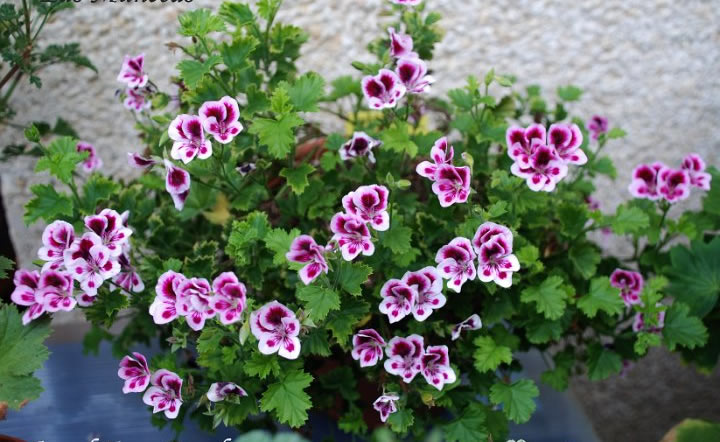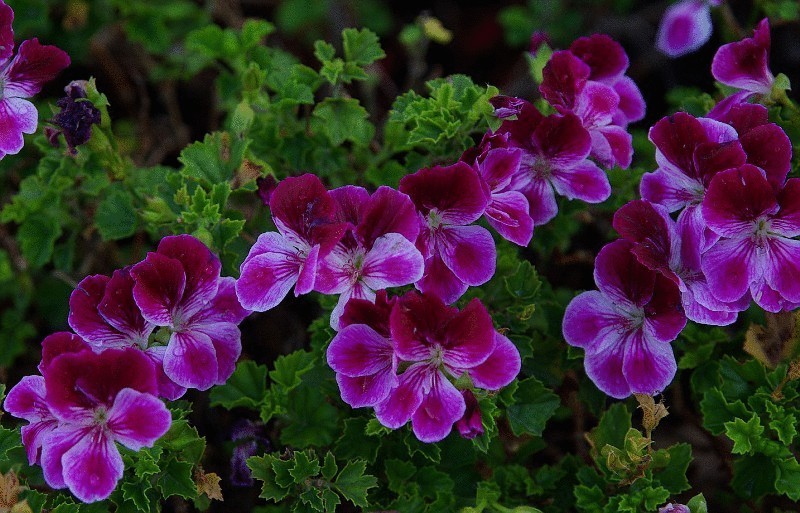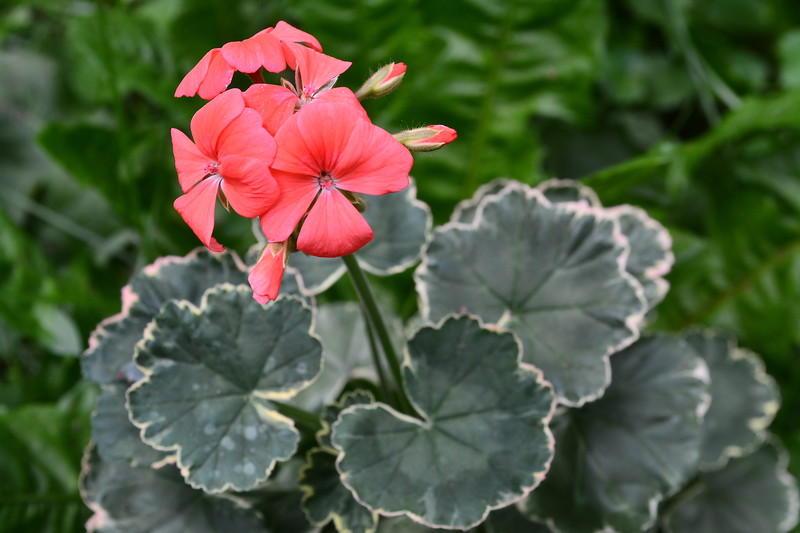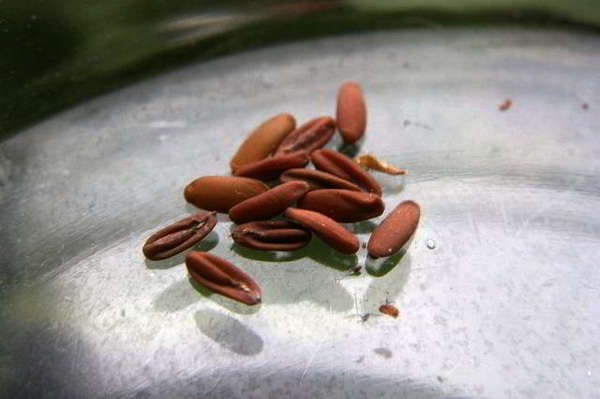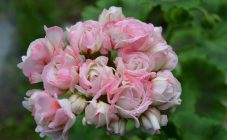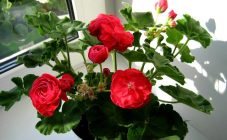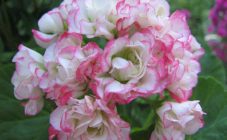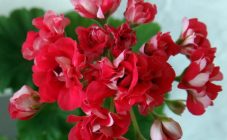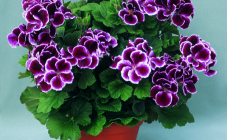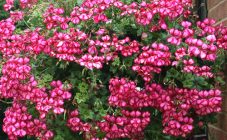Content:
Pelargonium leaves are varied in color and shape, and their aroma is impossible not to remember. The flower responds to a weak touch with the most delicate scent of rose and apple, cinnamon, mint or lemon. Fragrant pelargonium is the highlight of any flower garden. How to plant it and then care for the plant is described below.
History of culture and its useful properties
As a wild plant, Pelargonium fragrant was discovered in Africa at the Cape of Good Hope. On its basis, European breeders have bred many species that differ in leaf shape and color of flowers. The unifying property of all subspecies is the aroma, which cannot be confused with any other.
The glands produce this specific odor in the form of the finest hairs on the surface of the leaf and stem. They secrete phytoncides that can kill harmful microbes in the air.
An essential oil is obtained from pelargonium, for which it is grown on large areas.
Even in ancient times, it was considered a medicinal plant. Its aroma frightened off insect parasites, and people were treated with decoctions and infusions. Scientists have found a large amount of biologically active substances in the flower that have anti-inflammatory and regenerative properties.
Plant characteristic
Pelargonium is a herbaceous perennial plant, sometimes it is confused with geranium. Despite the similarity, these plants have different genetic characteristics, they cannot be crossed. The flowers of fragrant pelargoniums do not differ in particular decorativeness, they are small, have a dull color, although large-flowered representatives of the species have also been bred. There are varieties that do not give flowers at all in an apartment, they are brought up for the sake of fragrant leaves.
Pelargonium has a branched stem, the color of the leaves can be monochromatic or interspersed with red, and sometimes the entire leaf is crimson. In terms of color saturation, the leaves are both dark green and pale, slightly yellowish. They are round in shape with wavy edging. The root system is powerful, which is typical for drought-resistant plants.
The inflorescence of fragrant pelargonium has the shape of an umbrella type, the flowers are five-petal.
Pelargoniums are pollinated by bees, at home it has to be done manually. This method has its advantages: if you cross two varieties, you can get an original, previously unknown variety. This manipulation includes the following steps:
- collecting pollen from the "father" plant on the first day of flowering;
- removal of stamens from the flowers of the "mother" plant;
- pollination of the pistil of the mother flower on the second day of flowering, this operation is carried out with a brush;
- repeating the procedure the next day.
After that, fruits should form in place of the flowers. The seeds of this plant resemble coffee beans in appearance, only much smaller. The fruits are asymmetric brown seed pods, which open when ripe, and the seeds remain hanging on thin threads. They need to be collected before they crumble.
Description of crop varieties
Most varieties of fragrant pelargonium are derived from Pelargonium graveolens (fragrant pelargonium). The most common varietal varieties:
- Pelargonium Chocolate Peppermint (felt). The name was given by the spots on the chocolate-colored leaves. The bush has a height of no more than 30 cm, the shoots are slightly drooping, the flowers are pale pink with purple pubescence. The leaves are velvety to the touch, similar in shape to the five-fingered footprint of an animal. The bush smells like mint.
- The capitate P. Capitatum Attar of Roses is a tall bush with triangular leaves bordered with wavy fringes. The flowers are lilac-pink.
- Curly P. Crispum Cy's Sunburst has a pronounced lemon aroma. Its leaves are small, light green with a corrugated yellowish border. The flowers are pink.
- The pink P. Radens Red-Flowered Rose is distinguished by its delicate leaves and bright red flowers. Drought resistant.
- Gray Sprite - variegated pelargonium. It is appreciated for the exceptional decorativeness of the leaves.
Features of planting and caring for fragrant pelargonium
This plant is unpretentious, the growing rules are simple and she responds to their observance with gratitude.
It is better to place pelargonium at the western or eastern window, and at the southern one, where direct sunlight illuminates the place for a long time, the plant should be shaded. From a lack of light, the bush loses its attractive appearance, stretches, the foliage turns pale.
As a soil, it is preferable to buy a ready-made substrate for indoor plants, but you can also prepare it by adding sand to the garden soil. At the bottom of the pot, it is imperative to place drainage from expanded clay, broken brick or crushed stone.
The ideal temperature is 20 ° C. In winter, the room with pelargonium is ventilated, and in summer it is better, if possible, to take the flower out into the fresh air. Temperatures below 10 ° C are detrimental to pelargonium.
Care consists of watering, dressing, pinching and pruning.
All pelargoniums are drought-resistant plants, therefore they cannot tolerate excess moisture. Watering should be done as the top layer of the soil dries up. The planting vessel should be only 2 cm wider than the earthen lump, otherwise in a large container the plant will spend energy on developing the root system to the detriment of the green mass.
It is useful to water the plant with iodine water. This will have a beneficial effect on the growth of leaves and flowers. One drop of iodine tincture per 1 liter of water is enough to obtain a solution of the required concentration.
It is recommended to start forming a bush from the very beginning of growth. It consists in pinching the tops to form new lateral shoots. This procedure will allow you to get a neat lush bush.
Pruning is carried out in November, removing dead and dried shoots, faded flowers and yellowed leaves.
Reproduction
Pelargonium is easy to propagate with both seeds and cuttings.
The shoot is cut from the top of the bush, it should have 4-5 leaves. Rooted in water, you can add aloe juice, yeast or honey as a stimulant. When rooting is complete, they are planted in pots and placed away from direct sunlight. In addition to timely watering, no other care is required.
It is difficult to propagate many crops by seeds; fragrant pelargonium does not apply to them. Winter is considered optimal for sowing.
Seeds with hard shells already removed are usually commercially available and can be sown immediately. If the seeds are harvested on their own, you will have to remove the shell yourself. To do this, each seed is rubbed on sandpaper until the hard layer is removed. The process of obtaining seedlings from seeds consists of the following stages:
- preparation of soil from peat, turf and sand;
- seed treatment with epin and soaking for 3 hours in water;
- seeds are sown at intervals of 5 cm, sprinkled with a layer of soil no more than 0.5 cm, cover the containers with foil.
The seedlings will begin to sprout 2 weeks after sowing. When real leaves are formed on them, they begin to dive.
Major diseases and pests
Pelargonium is susceptible to diseases such as black leg and gray rot. It is impossible to get rid of the first ailment, prevention is a careful examination when buying a seedling. Gray rot manifests itself in the form of plaque on the leaves, and if it is found, you must immediately stop watering, remove the affected fragments and treat the bush with a fungicide solution.
Of the pests, aphids and whiteflies are affected, which settle on the inside of the leaves. To get rid of the bush, wash it with soapy water and spray it with an insecticide.
Breeding pelargonium is not difficult at all, and the result will be a pleasant, aromatic atmosphere and comfort in the house.

